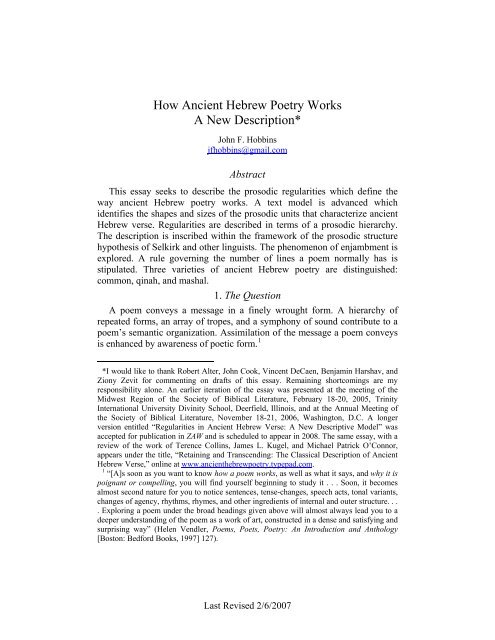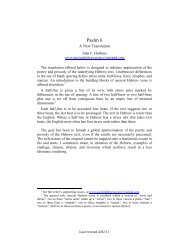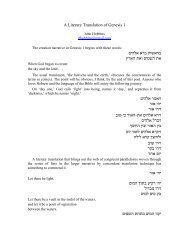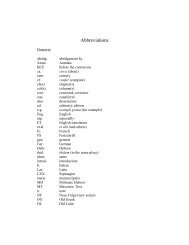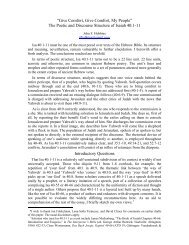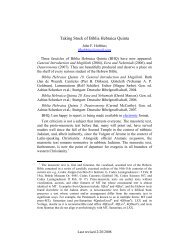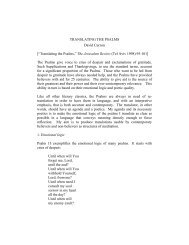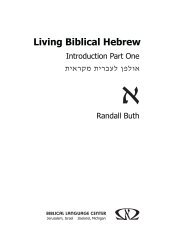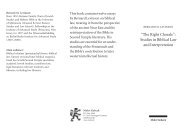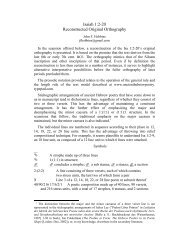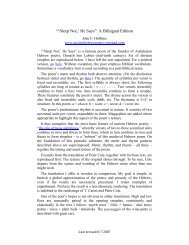Hebrew Poetry - Ancient Hebrew Poetry - Typepad
Hebrew Poetry - Ancient Hebrew Poetry - Typepad
Hebrew Poetry - Ancient Hebrew Poetry - Typepad
You also want an ePaper? Increase the reach of your titles
YUMPU automatically turns print PDFs into web optimized ePapers that Google loves.
How <strong>Ancient</strong> <strong>Hebrew</strong> <strong>Poetry</strong> WorksA New Description*John F. Hobbinsjfhobbins@gmail.comAbstractThis essay seeks to describe the prosodic regularities which define theway ancient <strong>Hebrew</strong> poetry works. A text model is advanced whichidentifies the shapes and sizes of the prosodic units that characterize ancient<strong>Hebrew</strong> verse. Regularities are described in terms of a prosodic hierarchy.The description is inscribed within the framework of the prosodic structurehypothesis of Selkirk and other linguists. The phenomenon of enjambment isexplored. A rule governing the number of lines a poem normally has isstipulated. Three varieties of ancient <strong>Hebrew</strong> poetry are distinguished:common, qinah, and mashal.1. The QuestionA poem conveys a message in a finely wrought form. A hierarchy ofrepeated forms, an array of tropes, and a symphony of sound contribute to apoem’s semantic organization. Assimilation of the message a poem conveysis enhanced by awareness of poetic form. 1*I would like to thank Robert Alter, John Cook, Vincent DeCaen, Benjamin Harshav, andZiony Zevit for commenting on drafts of this essay. Remaining shortcomings are myresponsibility alone. An earlier iteration of the essay was presented at the meeting of theMidwest Region of the Society of Biblical Literature, February 18-20, 2005, TrinityInternational University Divinity School, Deerfield, Illinois, and at the Annual Meeting ofthe Society of Biblical Literature, November 18-21, 2006, Washington, D.C. A longerversion entitled “Regularities in <strong>Ancient</strong> <strong>Hebrew</strong> Verse: A New Descriptive Model” wasaccepted for publication in ZAW and is scheduled to appear in 2008. The same essay, with areview of the work of Terence Collins, James L. Kugel, and Michael Patrick O’Connor,appears under the title, “Retaining and Transcending: The Classical Description of <strong>Ancient</strong><strong>Hebrew</strong> Verse,” online at www.ancienthebrewpoetry.typepad.com.1 “[A]s soon as you want to know how a poem works, as well as what it says, and why it ispoignant or compelling, you will find yourself beginning to study it . . . Soon, it becomesalmost second nature for you to notice sentences, tense-changes, speech acts, tonal variants,changes of agency, rhythms, rhymes, and other ingredients of internal and outer structure. . .. Exploring a poem under the broad headings given above will almost always lead you to adeeper understanding of the poem as a work of art, constructed in a dense and satisfying andsurprising way” (Helen Vendler, Poems, Poets, <strong>Poetry</strong>: An Introduction and Anthology[Boston: Bedford Books, 1997] 127).Last Revised 2/6/2007
2That being so, a reader of ancient <strong>Hebrew</strong> poetry will eventually ask:What continuously operating principles of organization define how ancient<strong>Hebrew</strong> poetry works? 2 What formal structures set poetry apart fromnarrative or speech as they otherwise occur in ancient <strong>Hebrew</strong> literature? Arethere rules that govern the formation of a poetic line or composition, ruleswe do not fully understand, or have yet to be discovered?2. The Harshav-Alter Description of <strong>Ancient</strong> <strong>Hebrew</strong> VerseThe most fitting description of ancient <strong>Hebrew</strong> verse known to the writeris that of Benjamin Harshav [Hrushovski] as summarized by Robert Alter:Hrushovski proposes a “semantic-syntactic-accentual rhythm” as the basis ofbiblical verse. “In most cases,” he observes, “there is an overlapping of severalsuch heterogeneous parallelisms with a mutual reinforcement so that no singleelement - meaning, syntax, or stress - may be considered as purely dominant oras purely concomitant.” The result is what Hrushovski defines as a “freerhythm” . . . [nevertheless,] the freedom of the rhythm “is clearly confinedwithin the limits of its poetics.” These limits are in part numerically demarcated,as Hrushovski [notes]: “[Since] by rule no two stresses are permitted to followeach other . . . each stress dominates a group of two, three, or four syllables;there are two, three, or four such groups in a verset; and two, three, or fourparallel versets in a sentence.” 3Mutually reinforcing parallelisms of meaning, syntax, and stress, asHarshav sees it, are the hallmark of ancient <strong>Hebrew</strong> poetry. These occurwithin a system of “twos, threes, and fours”: “stress-units” made up of two,three, or four syllables, “versets” made up of two, three, or four stress units,and “sentences” made up of two, three, or four versets. The rhythm ofstresses is so strong, Harshav notes, that it sometimes serves as the sole2 “[A]s soon as we perceive that a verbal sequence has a sustained rhythm, that it isformally structured according to a continuously operating principle of organization [myitalics], we know that we are in the presence of poetry and we respond to it accordingly”(Barbara Herrnstein Smith, Poetic Closure: A Study of How Poems End [Chicago:University of Chicago Press, 1968], 23; quoted in Robert Alter, The Art of Biblical <strong>Poetry</strong>[New York: Basic Books, 1985] 6).3 Alter, Art of Biblical <strong>Poetry</strong>, 8, quoting from B. Hrushovski, “Prosody, <strong>Hebrew</strong>,” EncJud13 (1971) cols. 1195-1240; 1200-1202. Harshav’s analysis benefits from his grasp of theentire history of <strong>Hebrew</strong> prosody. Not to be overlooked is his brief synopsis entitled, “Noteon the Systems of <strong>Hebrew</strong> Versification,” in The Penguin Book of <strong>Hebrew</strong> Verse (ed. T.Carmi; Harmondsworth: Penguin, 1981), 57-72; the “Preface,” “Introduction,” “Note onMedieval <strong>Hebrew</strong> Genres,” and “Table of Poems” by T. Carmi in the same volume, and thepoems themselves; at least those in “Part One: To the Tenth Century,” deserve a widereading among biblical scholars (7-12; 13-50; 51-55; 77-143; 147-274).Last Revised 2/6/2007
3support of parallelism across contiguous versets. A verset of two to fourstress units is unfailingly followed by another verset of two to four stressunits. Within and across the prosodic frames demarcated by stressparallelisms, a gamut of freely distributed sonic parallelisms also findsexpression. As Harshav remarks elsewhere, the process of interaction ofsounds and meanings encourages a selection and reemphasis of elementsfrom both sides. 4Harshav’s description is not ideal in all details. The concept of a“sentence” is a slippery one. Alter is right to speak more neutrally of “two orthree parallel versets constituting a poetic line.” 5 Alter is also not amiss indoing without the possibility of a line made up of four versets. Four versetunits subdivide without fail into pairs of two verset units. The notion that atwo to three part line is characteristic of ancient <strong>Hebrew</strong> verse is widelyaccepted for that reason.Harshav and Alter reclaim the method of primary stress analysisassociated with the names of Julius Ley and Eduard Sievers. 6 Innumerablescholars have engaged in the analysis of stress parallelisms. The work ofGeorge Buchanan Gray, Joachim Begrich, Hans Wildberger, Luis AlonsoSchökel, and Leslie Allen might be singled out. All applied the stresscountingmethod to a large corpus of texts in a consistent manner. 74 Hrushovski, “Prosody,” 1202; idem, “The Meaning of Sound Patterns in <strong>Poetry</strong>: AnInteraction Theory,” Poetics Today 2/1 (1980) 39-56; 43.5 Art of Biblical <strong>Poetry</strong>, 9.6 I discuss the contributions of Ley and Sievers in “Meter in <strong>Ancient</strong> <strong>Hebrew</strong> <strong>Poetry</strong>: AHistory of Modern Research,” www.ancienthebrewpoetry.typepad.com.7 Joachim Begrich, “Zur hebräische Metrik,” TRu NF 4 (1932) 67-89; “Der Satzstil imFünfer,” ZS 9 (1933-34) 169-209; repr. idem, Gesammelte Studien zum Alten Testament (ed.Walther Zimmerli; TB 21; Munich: Chr. Kaiser, 1964) 132-67; George Buchanan Gray (TheForms of <strong>Hebrew</strong> <strong>Poetry</strong> [London: Hodder & Stoughton, 1915; repr. Eugene: Wipf & Stock,2002)]; idem, Isaiah I-XXXIX [chs. 1-27 alone are covered] [ICC; Edinburgh: T & T Clark,1912]; Samuel R. Driver and George B. Gray, Job [Gray is responsible for the discussion ofrhythms in the introduction and notes] [ICC; Edinburgh: T & T Clark, 1912]); Luis AlonsoSchökel, Estudios de poética hebrea (Barcelona: Juan Flors, 1963) 165-88 [Isa 1-21]; 188-89 [Isa 43-44]; 451-87 [Isa 24-27]; 489-523 [Isa 28-30]; Hans Wildberger, Jesaja: 1.Teilband: Jesaja 1-12 (2d ed., BKAT 10/1; Neukirchen-Vluyn: Neukirchener Verlag, 1980[ET Isaiah 1-12 (CC; Minneapolis: Fortress, 1990)]; idem, Jesaja: 2. Teilband: Jesaja 13-27 (BKAT 10/2, Neukirchen-Vluyn: Neukirchener Verlag, 1978 [ET Isaiah 13-27 (CC;Minneapolis: Fortress, 1997)]; idem, Jesaja: 3. Teilband: Jesaja 28-39 (BKAT 10/3;Neukirchen-Vluyn: Neukirchener Verlag, 1982 [ET Isaiah 28-39 (CC; Minneapolis:Fortress, 2002)]; Leslie C. Allen, Psalms 101-150 (2d ed.; WBC 21; Nashville: ThomasNelson, 2002).Last Revised 2/6/2007
43. A New DescriptionIf there is a part of the description of ancient <strong>Hebrew</strong> verse as set forth byHarshav and Alter that requires qualification, it is, nevertheless, that whichdeals with patterns of stress parallelism. Alter’s overview makes an excellentstarting point:The rule is that there are never less than two stresses in a verset and nevermore than four and that no two stresses follow each other without an interveningunstressed syllable; and there are often asymmetrical combinations of 4+3 or3+2. 8Alter is here restating a rule deemed well-established in the eyes of thosetrained in the system of Ley and Sievers, and applied, for example, to thepoetry contained in Job by Gray, to that contained in Isa 1-39 by Wildberger,and to Pss 101-150 by Allen. 9The rule works remarkably well, but that doesn’t mean it is beyondimprovement. The assumption that no two stresses follow each other withoutat least one intervening syllable deserves re-examination. The rule abandonsthe patterns of stress retention reflected in MT insofar as it reduces twostresses to one where two stressed syllables in MT do follow each otherwithout an intervening syllable. For example:הוֹי גּוֹי חֹטֵ אעַ ם כֶּ בֶ ד עָ ו ֹןעַ ל מֶ ה תֻ כּוּ עוֹדעָ רֵ יכֶ ם שְׂ רֻ פוֹת אֵ שׁצֶ דֶ ק יָלִ ין בָּ הּ---- --הוֹי גּוֹי חֹטֵ אעַ ם כֶּ בֶ ד עָ ו ֹןעַ ל מֶ ה תֻ כּוּ עוֹדעָ רֵ יכֶ ם שְׂ רֻ פוֹת אֵ שצֶ דֶ ק יָלִ ין בָּ הּ Isa 1:4 Isa 1:4 Isa 1:5 Isa 1:7 Isa 1:21Isa 1:4 Oh sinner nation! Oh-nation sinful!Isa 1:4 Iniquity laden people People-laden with-iniquityIsa 1:5 Why shall-you-be-hit again? Why shall-you-be-hit-again?Isa 1:7 Your-cities consumed with-fire Your-cities consumed-with-fireIsa 1:21 Justice dwells in-her Justice dwells-in-herThe “no two stresses in a row” rule looks like an overgeneralization. Thereceived tradition’s frequent non-avoidance of two stresses in a row is8 Alter, “Characteristics of <strong>Ancient</strong> <strong>Hebrew</strong> <strong>Poetry</strong>,” 613. For a description of the varietiesof rhythmic stress patterns in ancient <strong>Hebrew</strong> poetry, modifiable along the lines I suggesthere, see Gray, Forms of <strong>Hebrew</strong> <strong>Poetry</strong>, 157-85.9 Gray, Job; Wildberger, Jesaja; Allen, Psalms 101-150.Last Revised 2/6/2007
5retainable in almost all cases without creating a conflict with the rule as awhole.It may further be suggested that 4:3 and 3:4 bipartite lines are betterunderstood as tripartite lines of (2:2):3 and 3:(2:2) format. Notwithstandingthe fact that in lines of this type, the main caesura falls between a unit of 4and a unit of 3, it is remarkable that 4’s are consistently divisible into pairsof 2’s. If instead we found units of 4 that must be analyzed as combinationsof 1 and 3, units of 4 on a par with units of 2 and 3 would have to beaccepted. Such is not the case. Exceptions to the rule that 4’s are divisibleinto pairs of 2’s in the received text are rare to the point that one may askwhether they might be the result of inopportune scribal embellishment orfaulty textual transmission.If the rule is modified accordingly, it reads as follows:There are never less than two stresses in a verset and never more than three.This rule, taken together with Alter’s definition of a line as beingcomposed of two or three versets, amounts to a refinement of Harshav’ssystem of “twos, threes, and fours.” Further analysis suggests the following“general rule”:<strong>Ancient</strong> <strong>Hebrew</strong> poetry is confined within a system of “twos and threes”: twoto three “stress units” make up a “verset”; two to three versets a poetic “line”;two to three lines a “strophe”; two to three strophes a “stanza”; two to threestanzas a “section”; and two to three sections a poem, or a more extensivesection thereof.The poetic line occupies the middlemost position in the hierarchy of theprosodic system canvassed by the general rule. Below it are the versets thatmake up the line and the stress units that make up the verset. Above it are thestrophes, stanzas, and sections that make up a poem. 10The general rule may be restated in terms of a metrical grid and a set ofrules that generate all known lines of ancient <strong>Hebrew</strong> verse. The resultssuggest the possibility of describing the line in terms of two minor and onemajor caesura if bipartite, and three minor, two major, and one super-majorcaesura if tripartite. 1110 I borrow the terms “verset” and “line” from Harshav [Hrushovski] and Alter, and theterms “strophe” and “stanza” from Fokkelman, Reading Biblical <strong>Poetry</strong>, 37.11 Paul Vetter described these caesurae long ago (Die Metrik des Buches Job [BiblischeStudien II.4; Freiburg i. Br.: Herder, 1897] 17; cited by Édouard Dhorme, Le Livre de Job[Paris: Gabalda, 1926]; ET A Commentary on the Book of Job [tr. Harold Knight; London:Thomas Nelson, 1967] clxxxv, n. 3). For a description of the line in terms of a metrical grid,Last Revised 2/6/2007
6The levels of the prosodic hierarchy as defined in the general rule requirefurther elucidation. I inscribe my discussion within the theoreticalframework of the prosodic structure hypothesis formulated by ElisabethSelkirk and other linguists. 12Translated into the terms of this hypothesis, a stress unit is equivalent to a“prosodic word,” a verset to a “phonological phrase,” a line to an“intonational phrase,” and a strophe to an “utterance.” These equivalencesare discussed below.4. Prosodic DomainsThe fundamental building block of ancient <strong>Hebrew</strong> verse is the prosodicword. There are also prosodic levels below the word which impact ancient<strong>Hebrew</strong> poetry’s rhythms and regularities. They are discussed further on.A prosodic word is a unit dominated by a single main stress whosedimensions are equivalent to an orthographic word to which free-standingprepositions and a few other short words may be cliticized. The concept ofthe prosodic word has proven to be of immense utility in the study oflanguages and verse around the world. Its existence is well-attested inTiberian Biblical <strong>Hebrew</strong> (TBH). The phonological and syntacticcombinations that play a role in the rules that determine the boundaries ofsee the writer’s “The Poetic Line in <strong>Ancient</strong> <strong>Hebrew</strong>: A Grid Analysis” at www.ancienthebrewpoetry.typepad.com.12 The study of the prosodic structure of verse is a preoccupation of linguists. See FormalApproaches to <strong>Poetry</strong>: Recent Developments in Metrics (ed. B. Elan Dresher and NilaFriedberg; Phonology and Phonetics 11; Berlin: Mouton de Gruyter, 2006); further, BruceHayes and Margaret MacEachern, “Are there Lines in Folk <strong>Poetry</strong>?” UCLA Working Papersin Phonology 1 (1996) 125-42; Bruce Hayes and Abigail Kaun, “The Role of PhonologicalPhrasing in Sung and Chanted Verse,” The Linguistic Review 13 (1996) 243-303; BruceHayes and Margaret MacEachern, “Quatrain Form in English Folk Verse,” Language 74(1998) 473-507; appendices online at www.humnet.ucla.edu/humnet/linguistics/people/hayes/metrics.htm. For Selkirk’s contributions, see my “Annotated Bibliography,” atwww.ancienthebrewpoetry.typepad.com. The standard introduction to prosodic structuretheory is Marina Nespor and Irene Vogel, Prosodic Phonology (Studies in GenerativeGrammar 28; Dordrecht: Foris, 1986). Briefer treatments include Bruce Hayes, “TheProsodic Hierarchy in Meter,” in Rhythm and Meter (ed. Paul Kiparsky and GilbertYoumans; Phonetics and Phonology 1; San Diego: Academic Press, 1989) 201-260; CarlosGussenhoven and Haike Jacobs, Understanding Phonology (2d ed.; UnderstandingLanguage Series; London: Hodder Arnold, 2005) 217-32. I argue elsewhere that ancient<strong>Hebrew</strong> verse instantiates a prosodic system in conformity with Selkirk’s Strict LayerHypothesis. See “In Search of Prosodic Domains in <strong>Ancient</strong> <strong>Hebrew</strong> Verse: Lamentations 1-5 and the Prosodic Structure Hypothesis,” www.ancienthebrewpoetry.typepad.com.Last Revised 2/6/2007
7prosodic words in TBH have been studied by Elan Dresher. 13 The rules thatapplied in ancient <strong>Hebrew</strong> must be inferred from the data in hand. As a firstapproximation, departures from the received tradition’s rules are best kept toa minimum, unless they follow from historically probable phonologicalchanges posited on independent grounds. Elsewhere I present a set ofreconstructed rules for ancient <strong>Hebrew</strong>. 14Excursus on Tiberian <strong>Hebrew</strong> PhonologyRecorded aspects of Tiberian <strong>Hebrew</strong> phonology include primary andoccasionally secondary stress assignment, prosody-driven vowel alteration, sandhi,rhythm rules, lenition, fortition, and deceleration markers below the word level; andpausal and contextual forms and intonational pauses and liaisons at higher levels.Medieval texts documenting reading traditions record understandings of vowellength and phonological structure. 15 Analogues to many of these featuresundoubtedly existed in ancient <strong>Hebrew</strong>, and impacted the way ancient <strong>Hebrew</strong>poetry worked. Nonetheless, one must guard against relying on features like thelenition of stops that probably did not obtain in ancient <strong>Hebrew</strong>. 1613 Bezalel Elan Dresher, “The Prosodic Basis of the Tiberian <strong>Hebrew</strong> System of Accents,”Language 70 (1994) 1-52; “The Word in Tiberian <strong>Hebrew</strong>,” in The Nature of the Word:Essays in Honor of Paul Kiparsky (ed. Kristin Hanson and Sharon Inkelas; Cambridge: MITPress, in press); online: http://www.chass.utoronto.ca/~dresher/tibhebword.pdf. Of crosslinguisticinterest: Draga Zec, “On the Prosodic Status of Function Words,” Working Papersof the Cornell Phonetics Laboratory 14 (2002) 1-34; online: http://ling.cornell.edu/Zec/PaperLatest1.pdf; idem, “The Prosodic Word as a Unit in Poetic Meter,” in The Nature ofthe Word: Essays in Honor of Paul Kiparsky (ed. Kristin Hanson and Sharon Inkelas;Cambridge: MIT Press, in press); online: http://ling.cornell.edu/Zec/PaperFinal1.pdf.14 “Stress in <strong>Ancient</strong> <strong>Hebrew</strong>: A Tentative Reconstruction” at www.ancienthebrewpoetry.typepad.com.15 On the phonology of Tiberian <strong>Hebrew</strong>, see Alan S. Prince, The Phonology andMorphology of Tiberian <strong>Hebrew</strong> (Ph.D. diss., MIT; 1975); John J. McCarthy, FormalProblems in Semitic Phonology and Morphology (1979 Ph.D. diss., MIT; Indiana UniversityLinguistics Club ed., 1982; repr. New York: Garland, 1985); Geoffrey Khan, “VowelLength and Syllable Structure in the Tiberian Tradition of Biblical <strong>Hebrew</strong>,” JSS 32 (1987)23-82; Joseph L. Malone, Tiberian <strong>Hebrew</strong> Phonology (Winona Lake: Eisenbrauns, 1993);Henry Churchyard, Topics in Tiberian Biblical <strong>Hebrew</strong> Metrical Phonology and Prosodics(Ph.D. diss.; University of Texas, Austin, 1999), http://www.crossmyt.com/hc/linghebr/index/ html, 1-121; and Andries Coetzee, Tiberian <strong>Hebrew</strong> Phonology: Focussingon Consonant Clusters (SSN 38; Assen: Van Gorcum, 1999).16 The attempt of Jerzy Kurylowicz (“Three Semitic Metrics,” in idem, Studies in SemiticGrammar and Metrics [Prace Językoznawcze 67; Wroclaw: Polska Akademia Nauk, 1972]158-87), followed by Alan M. Cooper (Biblical Poetics: A Linguistic Approach [Ph.D. diss.,New Haven: Yale University, 1976] 32-34) to infer a system of meter for ancient <strong>Hebrew</strong>poetry based on deformation, sandhi, and lenition/hardening in Tiberian Biblical <strong>Hebrew</strong>,was rightly judged a failure by W. Randall Garr (“The Qinah: A Study of Poetic Meter,Last Revised 2/6/2007
9The prosodic parse preserved by the accents captures a regularity easilyestablished by independent observation, namely, that tripartite structures are,virtually without exception, 1:(1:1) or (1:1):1 in structure. But attention tothe accents is not sufficient to identify lines. Knowledge of the general ruleis needed in order to lineate properly. 18An intonational phrase in prosodic structure theory is marked off from itsenvironment by intonational boundary tones, pauses, final lengthening,and/or other phonological features. It contains one or more phonologicalphrases.A line as defined above is equivalent to an intonational phrase. Itsparameters are fixed, ex hypothesi, at from 2 to 3 phonological phrases. Theouter boundaries of intonational phrases are often but not consistentlymarked in the MT by its subdivision of the text into pesuqim or by majorsubdivisions of same.An utterance in prosodic structure theory is a still larger intonational unit.The utterance level of the prosodic hierarchy delimits self-contained unitiesof discourse. Utterances are closed by intonational full stops or similar. Astrophe as defined above is equivalent to an utterance. Ex hypothesi, itconsists of 2 to 3 intonational phrases.Strophes are often identifiable with relative ease in ancient <strong>Hebrew</strong> verse.In poetry outside of Psalms, Proverbs, and Job, a pasuq or masoretic versenormally consists of an utterance as just defined. Gray spoke of these unitsas “sections” and observed that the parallelisms that occur across distichsand tristichs occur across sections as well. His remarks are based on ananalysis of Lamentations 1-4 in which strophes of 2 to 3 lines are marked bypesuqim and/or by the acrostic scheme. 19A number of text segments usually scanned as single poetic lines arescanned as pairs of lines under the general rule. The following sets of lines, 2to 3 in number, each constitute a pasuq in MT and an utterance or strophe asdefined above:2:2 Ps 46:72:2מָ טוּ מַ מְ לָ כוֹתהָ מוּ גוֹיִםתָּ מוּג אָ רֶ ץנָ תַ ן בְּ קוֹלוֹ מֵ חֵ לֶ ב גִּ בּוֹרִ יםמִ דַּ ם חֲ לָ לִ ים ל ֹא נָשׂוֹג אָ חוֹרקֶ שֶׁ ת יְהוֹנָ תָ ן 2:2 2 Sam 1:222:318 I demonstrate this point in “In Search of Prosodic Domains.”19 Forms of <strong>Hebrew</strong> <strong>Poetry</strong>, 87-120.Last Revised 2/6/2007
102:32:22:22:2Ps 46:7וְ חֶ רֶ ב שָׁ אוּלל ֹא תָ שׁוּב רֵ יקָ םמָ תְ נַי חַ לְ חָ לָ העַ ל- כֵּ ן מָ לְ אוּ כְּ צִ ירֵ י יוֹלֵ דָ הצִ ירִ ים אֲ חָ זוּנִי נִ בְ הַ לְ תִּ י מֵ רְ אוֹתנַעֲ וֵ יתִ י מִ שְּׁ מֹעַ Nations rage,kingdoms topple;he gives forth his voice,the earth melts.2 Sam 1:22 From blood of the slain,from fat of the mighty,the bow of Jonathandid not turn back,the sword of Sauldid not return empty.Isa 21:3Therefore my loinsare full with trembling,pangs seize melike a woman in travail;I am too distraught to hear,too frightened to see.5. Beyond the Level of Strophe or UtteranceIsa 21:3A unit consisting of two or three utterances, referred to as a stanza in thegeneral rule, has no equivalent in prosodic structure theory. Stanzas also lacka firm foundation in the prosodic divisions preserved in MT. They are not asreadily identifiable as strophes or sections. Nevertheless, the assumption thatstanzas are composed of 2 to 3 strophes consistently yields acceptableresults.A unit consisting of 2 to 3 stanzas, referred to as a section in the generalrule, also has no equivalent in prosodic structure theory. The outerboundaries of a section are nevertheless clear in many instances.Occasionally, sections coincide with the division into open and closedparagraphs preserved in MT. Often, sections coincide with readilyidentifiable macrosemantic units.The largest identifiable prosodic unit of all under the general rule is a unitconsisting of one or more sections. It goes unnamed in prosodic structuretheory even if its existence is not questioned. In ancient <strong>Hebrew</strong> verse, theLast Revised 2/6/2007
11largest prosodic unit, consisting of one or more sections or combinations ofsections, is a poem or a cycle of poems. Sections often appear to be arrangedin diptychs and triptychs.6. The Frequency of Enjambment at the Line LevelClaims to the contrary notwithstanding, enjambment occurs frequently inancient <strong>Hebrew</strong> verse. One third of the lines in the corpus studied by him,O’Connor remarks, exhibit enjambment. More than two thirds of the lines inLamentations 1-5 are enjambed, according to a landmark study by F. W.Dobbs-Allsopp. 20 Under the general rule, enjambment recurs with greaterregularity than usually thought. Pairs of enjambed lines occupying a pasuqare not unusual:מִ פְּ נֵי זַ עְ מֶ ָךאֵ ין מְ תֹם בִּ בְ שָׂ רִ י מִ פְּ נֵי חַ טָּ אתִ יאֵ ין שָׁ לוֹם בַּ עֲ צָ מַ י מֵ רִ בְ בוֹת עָ םל ֹא אִ ירָ אשָׁ תוּ עָ לָ יאֲ שֶׁ ר סָ בִ יב 2:3גוֹי אֶ ל-גּוֹי חֶ רֶ ב ל ֹא יִ שָּׂ אעוֹד מִ לְ חָ מָ הוְ ל ֹא יִלְ מְ דוּ מִ כָּ ל בָּ נִ ים יָלָ דָ האֵ ין מְ נַ הֵ ל לָ הּ מִ כָּ ל בָּ נִ ים גִּ דֵּ לָ הוְ אֵ ין מַ חֲ זִ יק בְּ יָדָ הּ 3:2 Ps 38:43:22:22:22:23:33:3Ps 38:4Ps 3:7Isa 2:4bThere is no soundness in my fleshon account of your fury;there is no wellness in my frameon account of my sin.I am not afraidof myriad folkwho around aboutare arrayed against me.Nation shall not lift swordagainst nation,nor they shall learnwar anymore.Ps 3:7Isa 2:4bIsa 51:1820 O’Connor, <strong>Hebrew</strong> Verse Structure, 409; Frederick W. Dobbs-Allsopp, “The EnjambingLine in Lamentations: A Taxonomy (Part 1),” ZAW 113 (2001) 219-39; “The Effects ofEnjambment in Lamentations (Part 2),” ZAW 113 (2001) 370-95; 371.Last Revised 2/6/2007
12Isa 51:18None leads herof all the sons she bore,none takes her handof all the sons she reared.The division of single clauses into multipartite lines is not revolutionary.Isa 51:18 is so divided by NRSV and NJPSV. Further examples:3:2Lam 4:10 21Obad 12 22יְדֵ י נָשִׁ ים רַ חֲ מָ נִ יּוֹתהָ יוּ לְ בָ רוֹת לָ מוֹבִּ שְּׁ לוּ יַלְ דֵ יהֶ ןבְּ שֶׁ בֶ ר בַּ ת- עַ מִּ י 3:2בְּ יוֹם נָ כְ רוֹבְ יוֹם אָ חִ יָך וְ אַ ל תֵּ רֶ א בְּ יוֹם אָ בְ דָ םלִ בְ נֵי יְהוּדָ ה וְ אַ ל תִּ שְׂ מַ ח בְּ יוֹם צָ רָ הוְ אַ ל תַּ גְ דֵּ ל פִּ יָך (2:2):2(2:2):23:2Zeph 1:2-3 23אָ סֹף אָ סֵ ף כֹּל מֵ עַ ל פְּ נֵ י הָ אֲ דָ מָ ה נְ אֻ ם יְהוָ ה(3:3):23:(3:2)(2:3):2וּדְ גֵי הַ יָּםאָ סֵ ף עוֹף הַ שָּׁ מַ יִם אָ סֵ ף אָ דָ ם וּבְ הֵ מָ ה נְ אֻ ם יְהוָ המֵ עַ ל פְּ נֵ י הָ אֲ דָ מָ ה וְ הִ כְ רַ תִּ י אֶ ת- הָ אָ דָ ם עַ ל מִ שְׁ פְּ טֵ י צִ דְ קֶ ָךחֲ צוֹת לַ יְלָ ה אָ קוּם לְ הוֹדוֹת לָ ְך וּלְ שֹׁמְ רֵ י פִּ קּוּדֶ יָךלְ כָ ל אֲ שֶׁ ר יְרֵ אוָּך חָ בֵ ר אָ נִ י חֻ קֶּ יָך לַ מְּ דֵ נִ יָמלְ אָ ה הָ אָ רֶ ץ חַ סְ דְּ ָך יְהוָ ה (2:3):2 -(2:3):2(2:2):2Psalm119:62-64 24Lam 4:10Obad 12The hands of tenderhearted womenboiled their children;they became nourishment for themin the breakup of my beloved people.Would that you had not looked with satisfactionon the day of your brother,on the day of his calamity.Would that you had not rejoiced21 Division of text as in BHQ, NJPSV, and NRSV.22 Division of text as in NJPSV. Here and elsewhere, stress retention and deletion patternspreserved in MT are not a reliable guide to the delimitation of stress units in the underlyingtext. Stress deletion occurs more often than seems to be required. Maqqephim deemed tojoin primary stress units have been omitted.23 Division of text as in NJPSV. MT וְ הַ מַּ כְ שֵׁ לוֹת הָ רְ שָׁ עִ ים -אֶ ת Zeph 1:3 is omitted as an earlygloss. An equivalent is lacking in LXX and OL.24 Division of text as in Allen, Psalms 101-150, 172.Last Revised 2/6/2007
13Zeph 1:2-3Ps 119:62-64over the people of Judahon their day of ruin.Would that you had not distended your mouthon a day of distress.I will gather, gather up everythingfrom the face of the earth –oracle of Yahweh –I will gather up man and beast,I will gather up the fowl of the skyand the fish of the sea,and cut off manfrom the face of the earth –oracle of Yahweh.In the middle of the nightI rise to praise youfor your just decisions.I am a friendto all who fear you,to those who keep your precepts.With your favor, Yahweh,the earth is filled:teach me your laws.Two-clause (2:2):3 and 3:(2:2) lines are common in Job, Proverbs, andelsewhere:3:(2:2)(2:2):3(2:2):3(2:2):33:(2:2)Job 3:19 יַחַ ד אֲ סִ ירִ ים שַׁ אֲ נָ נוּ ל ֹא שָׁ מְ עוּ קוֹל נֹגֵ שׂקָ טֹן וְ גָ דוֹל שָׁ ם הוּא וְ עֶ בֶ ד חָ פְ שִׁ י מֵ אֲ דֹנָ יוצְ רוֹר הַ מֹּר דּוֹדִ י לִ י בֵּ ין שָׁ דַ י יָלִ יןעלַ -זֶ ה הָ יָה דָ וֶ ה לִ בֵּ נוּ עַ ל-אֵ לֶּ ה חָ שְׁ כוּ עֵ ינֵינוּגּוֹרָ לְ ָך תַּ פִּ יל בְּ תוֹכֵ נוּ כִּ יס אֶ חָ ד יִהְ יֶה לְ כֻ לָּ נוּJob 3:19 As one prisoners are at ease –none hearthe taskmaster’s voice;Small and great,there they are;the slave, free of his master.Cant 1:13A bag of myrrhCant 1:13Lam 5:17Prov 1:14Last Revised 2/6/2007
14Lam 5:17Prov 1:14is my love to me,between my breasts he lodges.Whereover we becamesick at heart;over this our eyes grew dim.Your lot you must throw in with us,a common pursethere’ll be for all of us.The main caesura in lines of this type falls between a unit of 4 and a unitof 3. The unit of 4 is consistently divisible into a pair of 2’s.7. Prosodic Domains below the WordAn account of regularities in ancient <strong>Hebrew</strong> verse cannot afford toignore prosodic domains below the prosodic word. Analysis indicates that aprosodic word is made up of one to three feet; a foot, of one to threesyllables; a syllable, of one to three morae. The analysis holds for ancient<strong>Hebrew</strong> in general, not just its poetry. A theoretical framework for the studyof prosodic domains at the foot level is offered by Bruce Hayes; at thesyllable level, by Matthew Gordon; at the mora level, by Abigail Cohn. 258. SyllablesUnder the general rule, prosodic word counts factor into any judgmentconcerning the wellformedness of a verset. But syllable counts are alsometrically diagnostic. Qinah verse illustrates the point. It is characterized bylines in which the second half is shorter than the first. A typical line is 3:2 interms of prosodic words. A frequent substitution consists of a 3:3, 2:2, or 2:3line in which the line’s second half is nonetheless shorter than the first interms of syllable count. Qinah meter is adequately defined only if bothprosodic word and syllable counts are considered. Qinah meter is describedin more detail below.25 Bruce Hayes, Metrical Stress Theory: Principles and Case Studies (Chicago: Universityof Chicago Press, 1995); Matthew Gordon, Syllable Weight: Phonetics, Phonology andTypology (London: Routledge, forthcoming); idem, “Syllable Weight,” in Phonetic Basesfor Phonological Markedness, (ed. Bruce Hayes, Robert Kirchner, and Donca Steriade;Cambridge: Cambridge University Press, forthcoming); online at www.linguistics.ucsb.edu/faculty/gordon/syllableweight.pdf; Abigail C. Cohn, “Phonological Structure and PhoneticDuration: The Role of the Mora,” Working Papers of the Cornell Phonetics Laboratory 15(2003) 69-100. For a discussion of feet, syllables, and morae in ancient <strong>Hebrew</strong>, see thepresent writer’s “In Search of Prosodic Domains” at www.ancienthebrewpoetry.typepad.com.Last Revised 2/6/2007
15If a system of twos and threes is evident at the word level and above, at amore elementary level, that of syllables, the rhythm is freer, though notwithout constraints: one to six syllables is the syllable count up to andincluding the syllable receiving the dominant stress in a prosodic word. Thismeasure of the maximum length of a prosodic word is important in theestablishment of a threshold for the decliticization of proclitics. 26If one to six syllables make up a prosodic word, the number of syllablesin a verset will hypothetically fall in a range that goes from two to eighteenin a system of two and threes (in a system of two, threes, and fours, a two totwenty-four range would obtain). The range is far narrower in fact. It hasbeen customary to think in terms of averages. Analysis suggests that aprosodic word consists on average of between two and three syllables. Onaverage, therefore, there will be between four to nine syllables to a verset. Astatistical convergence in the range of four to nine syllables per verset iscompatible with the findings of Freedman, Fokkelman, and Bartelt, to citethree major practitioners of the syllable counting method. 27 Nevertheless,despite claims made for averages, it seems unlikely that this convergence ismore than an epiphenomenon of other regularities in <strong>Hebrew</strong> versestructure. 2826 Harm van Grol (De versbouw in het klassieke hebreeuws: Fundamentele verkenningen,Deel 1: Metriek [diss., Catholic Theological University of Amsterdam: Amsterdam, 1986]148-51, 240) also sets an upper limit of six syllables per stress unit. Stress units of more thanfive syllables up to and including the maximally stressed syllable are atypical. For areconstruction of rules governing the formation of prosodic words in ancient <strong>Hebrew</strong>, seethe present writer’s “Stress in <strong>Ancient</strong> <strong>Hebrew</strong>: A Tentative Reconstruction” atwww.ancienthebrewpoetry.typepad.com.27 David Noel Freedman, “Acrostics and Metrics in <strong>Hebrew</strong> <strong>Poetry</strong>,” HTR 65 (1972) 367-92; 392 (repr. in Pottery, <strong>Poetry</strong>, and Prophecy: Collected Essays on <strong>Hebrew</strong> <strong>Poetry</strong>(Winona Lake, Eisenbrauns, 1980) 51-76; 76 [six and a half to nine syllables per verset onaverage]; Jan Fokkelman, Reading Biblical <strong>Poetry</strong>, 47-8 [seven to nine syllables per verseton average, with 8 indicated as “the central norm figure of prosody”]; Andrew H. Bartelt,The Book around Immanuel: Style and Structure in Isaiah 2-12 (BJSUCSD 4; Winona Lake:Eisenbrauns, 1996) 247 [8 syllable norm for a verset].28 For syllable count averages to be more than a byproduct of overall regularity, one has toassume that poets reworked their poems until calculations proved a normative syllable countaverage had been achieved. This is not a likely scenario. Nevertheless, to judge fromEusebius of Caesarea, according to whom “it is said” that Deut 32 and Ps 119 “arecomposed in what the Greeks call heroic meter,” that is, “hexameters consisting of sixteensyllables” (Praep. ev. XI, 5), the practice of counting the syllables of ancient <strong>Hebrew</strong> verseis at least as old as the comparative study of Greek and <strong>Hebrew</strong> poetry.Last Revised 2/6/2007
169. Varieties of <strong>Ancient</strong> <strong>Hebrew</strong> VerseAggregate, not average syllable counts allow parameterization of varietiesof ancient <strong>Hebrew</strong> poetry. Three meters or systems of constraint areidentifiable.In common meter - most extant ancient <strong>Hebrew</strong> verse is written in it - thelength of versets and lines, with post-stress syllables not counted, isconstrained as follows: a verset contains no less than 2 but no more than 10syllables (absent the constraint, it might contain up to 18); a bipartite line, noless than 6 but no more than 18 syllables; a tripartite line, up to but no morethan 24 syllables. Common meter is flexible but still constrained. Examples:Isa 1:2-20; 40:1-11; Zeph 1-3.Qinah meter is more severely constrained. The “a” verset in a bipartiteline normally contains 5 to 8 syllables, the “b” verset 3 to 7 syllables; in atripartite line, each verset contains 3 to 5 syllables. Lines contain 9 to 14syllables. Qinah poetry is dominated by lines with a shorter or syncopatedsecond half, where “halves” or “half-lines” are defined as the text on eitherside of the major caesura (in a three verset line, the third or “c” versetconstitutes the second half). Occasionally, halves are equal in length; rarely,the second half is longer than the first. A 3:2 line is typical, but syncopationmay be achieved in more subtle ways. As a rule, lines with halves of equallength or a second half longer than the first by prosodic word count have ashorter second half in terms of syllables and/or absolute words.Compensation also occurs in reverse, such that lines with halves of equallength or a second half longer than the first by syllable count as a rule have ashorter second half in terms of prosodic words. Examples: Lam 1-4; Jon 2:3-10.Mashal meter is dominated by lines with half-lines of approximatelyequal length, where “half-lines” are defined as the text on either side of themajor caesura as above, and “approximately equal” is defined as plus orminus 3, or in some cases 2 syllables. Versets are characteristically 4 to 8syllables in length. Examples: Prov 1:10-33; 2:1-22; 8:1-21; Pss 111-112.Syllable counts reflect phonological length the parameters of which mayreflect time worn convention rather than systematic counting. Judgments onthe part of the individual poet were probably involved, but measurement oflength may have been intuitive rather than analytical. Occasional outliersmight thus be explained.Last Revised 2/6/2007
1710. What the General Rule Does Not RequireThe general rule does not require that a poem repeat itself measure formeasure in exactly the same way. Many forced attempts have been made toidentify a pattern such as 2:2, 3:3, or 3:2 as the dominant or exclusive one ofa given poem. With the exception of qinah meter, this can only beaccomplished by ad hoc promotion of secondary stresses to primary stressesand vice versa, unnatural divisions, and made to order textual emendation, orby establishing an unacceptably low threshold in terms of what qualifies as adominant pattern in a given poem. Intermingling of 2:2’s, 3:3’s, 3:2’s, etc. isconstitutive of the artistry of ancient <strong>Hebrew</strong> verse. Identifiableconstellations of the permissible rhythmic patterns occur locally, notglobally, within the framework of a given poem. Variation in the number ofprosodic units (prosodic words, feet, syllables, or mora) within continuouslyrepeated prosodic frames should not surprise. Earlier periods of severalpoetries are characterized by precisely such variation. 29Asymmetrical features counterpoint symmetrical features in ancient<strong>Hebrew</strong> verse. The twined acrostic poems of Pss 111 and 112, for example,make use of a compositional technique whereby a letter of the alphabetaccording to a conventional order initiates a unit consisting withoutexception of 3 or (2:2) prosodic words. Units of 3 and (2:2), but29 For the distinction between meter and rhythm, see the present writer’s “Glossary andDefinitions” at www.ancienthebrewpoetry.typepad.com. Not unlike ancient <strong>Hebrew</strong> verse,verse in Shor, Uzbek, and other Turkic languages, and Khanty, Mordvin-Moksha, and otherUralic languages, is characterized by a tolerance for lines of varying length withinmeasurable limits and a wealth of semantic and syntactic parallelisms. See Victor M.Zhirmunsky, “Rhythmico-Syntactic Parallelism as the Basis of Old Turkic Folk EpicVerse,” in idem, Selected Writing: Linguistics, Poetics (Moscow: Progress Publishers, 1985[orig. Russian, 1964]) 320-62; Ger. tr.; “Syntaktischer Parallelismus und rhythmischeBindung im alttürkischen epischen Vers,” in Beiträge zur Sprachwissenschaft, Volkskundeund Literaturforschung. Wolfgang Steinitz zum 60. Geburtstag am 28. Februar dargebracht(ed. Alexander V. Isacenko et al.; Veröffentlichungen der SprachwissenschaftlichenKommission, Deutsche Akademie der Wissenschaften zu Berlin 5; Berlin: Akademie-Verlag, 1965) 387-401; Wolfgang Steinitz, Der Parallelismus in der finnisch-karelischenVolksdichtung (Folklore Fellows Communications 115; Helsinki: SuomalainenTiedeakatemia, 1934) 4-14; idem, Ostjakologische Arbeiten (ed. Gert Sauer and RenateSteinitz; 4 vols.; Janua linguarum Series practica 254-57; Den Haag: Mouton, 1975-89).Early Japanese, early Slavic, early Spanish, and Old Latin poetries likewise exhibitconstrained variation in terms of the number of metrical units that make up a line or a colon.Orientations are found in the relevant articles of The New Princeton Encyclopedia of <strong>Poetry</strong>and Poetics (3d ed.; gen. ed. Alex Preminger and Terry V. F. Brogan; Princeton: PrincetonUniversity Press, 1993).Last Revised 2/6/2007
18approximately equal in terms of syllable count, are the compositions’building blocks. The variation adds pleasantness to what would otherwise bea monotonous sequence. Syntactically, an acrostic unit corresponds to aclause – except when it doesn’t. Prosodic and syntactic asymmetries acrossunits of approximately equal phonological length make the poetry lesstedious. Adjacent acrostic units combine to form lines and strophes inaccordance with the general rule, but do so in unpredictable ways. 3011. Regularities beyond the System of Twos and ThreesThe Length RuleOnce the lines of a poem are correctly identified, a length rule, that is, aset of regularities involving aggregate numbers of lines, is discernible:A poem, if it contains more than 10 lines, typically consists of 12, 18, 22, 28,or 36 lines, or combinations thereof. Among the Psalms, 14 lines is also acommon length.The rule delimits macro-units of poetry in terms of 12’s, 14’s, 18’s, 22’s,28’s, and 36’s. 31 Its validity cannot be demonstrated here. In conjunction30Pss 111-112 are composed in a kind of mashal meter in which half-lines ofapproximately equal syllabic length consist of 3 to 4 (not 2 to 4) prosodic words. See thewriter’s “Psalms 111-112,” online at: www.ancienthebrewpoetry.typepad.com.31 With respect to the number of lines a poem in ancient <strong>Hebrew</strong> typically has, I amindebted, if only indirectly, to Yehoshua Gitay (Prophecy and Persuasion: A Study of Isaiah40-48 [Forum Theologiae Linguisticae 14, Bonn: Linguistica Biblica, 1981]; “Reflectionson the Study of Prophetic Discourse: The Question of Isaiah I 2-20,” VT 33 [1983] 207-221;Isaiah and His Audience [Assen: Van Gorcum, 1991]). His insistence that we seek toidentify fully formed compositions in ancient prophetic literature, and not assume, as manydo, that all we have are snippets of prophetic discourse strung together and reworked for adifferent purpose by another hand, emboldened me early on to consider the possibilities.According to the length rule, larger compositions conform to strict conventions,confirmation of the correctness of David Noel Freedman’s intuition that large poeticstructures work within rigid constraints in terms of length (“Another Look at Biblical<strong>Hebrew</strong> <strong>Poetry</strong>,” in Directions in Biblical <strong>Hebrew</strong> <strong>Poetry</strong> (ed. Elaine R. Follis; JSOTSup40; Sheffield: Sheffield Academic Press, 1987) 11-28; 26; repr. in Divine Commitment andHuman Obligation: Selected Writings of David Noel Freedman, Volume Two: <strong>Poetry</strong> andOrthography (ed. John R. Huddleston; Grand Rapids: Eerdmans, 1997) 213-226; 225). 22line poems were identified in non-acrostic contexts by, among others, R. B. Y. Scott(Proverbs-Ecclesiastes [AB 18; Garden City: Doubleday, 1965] 71 [Prov 2:1-22]; MitchellDahood (Psalms I: 1-50 [AB 16; Garden City: Doubleday, 1966] 234 [Ps 38]); David NoelFreedman (“Acrostic Poems in the <strong>Hebrew</strong> Bible: Alphabetic and Otherwise,” CBQ 48[1986] 408-31; repr. in Divine Commitment and Human Obligation: Selected Writings ofDavid Noel Freedman, Volume Two: <strong>Poetry</strong> and Orthography (ed. John R. Huddleston;Grand Rapids: Eerdmans, 1997) 183-204; 197-202 [Ps 33]); Delbert R. Hillers(Lamentations [2d ed.; AB 7A; New York: Doubleday, 1992] 25 [Lam 5, Pss 33, 38, andLast Revised 2/6/2007
19with the general rule, the length rule unlocks the structure of poem afterpoem in ancient <strong>Hebrew</strong> literature.12. Precursors of the Description Offered HereThe general rule and the “seven-storied hierarchy” Harshav discerned inancient <strong>Hebrew</strong> verse are much alike. Harshav noted that each level of thehierarchy contains a group of units, usually 2 or 3, of the level below it, withthe order of 2’s and 3’s, as stressed above, ever-changing and unpredictable.Another scholar who has paid attention to prosodic hierarchy is VincentDeCaen. Harshav developed his insights on the basis of a keenunderstanding of poetry per se and in the context of a comprehensive literarytheory. DeCaen develops his in the context of contemporary linguistics. 32The text model proposed here and Jan Fokkelman’s text model overlap toa large degree. At the line, strophe, and stanza levels, but not at the versetlevel, Fokkelman perceives a system of twos and threes to be instantiated inbiblical poetry. 33 Given the difference at the verset level, my analyses differdecisively from his.103]); Pieter van der Lugt (Rhetorical Criticism and the <strong>Poetry</strong> of the Book of Job (OTS 32;Leiden: Brill, 1995) 124, 165, 299 [Job 10, 14, and 27]); idem, Cantos and Strophes inBiblical <strong>Hebrew</strong> <strong>Poetry</strong> with Special Reference to the First Book of the Psalter (OTS 53;Leiden: Brill, 2006) 421, 424 [Pss 33, 103]; Klaus Seybold, “Akrostische im Psalter,” TZ 57(2001) 172-183 [Pss 72, 103, 66]); Wilfred G. E. Watson, Traditional Techniques inClassical <strong>Hebrew</strong> Verse (JSOTSup 170, Sheffield: Sheffield Academic Press, 1994) 90[Lam 5; Ps 38]; Jan Fokkelman, Major Poems of the <strong>Hebrew</strong> Bible: At the Interface ofProsody and Structural Analysis. II. 85 Psalms and Job 4-14 (SSN 41; Assen: Van Gorcum,2000) 522 [Pss 33, 38]. I omit from this list poems thought by others to have 22 lines that inmy view do not. So far as I know, the other details of the length rule went unrecognized inthe past.32 Benjamin Harshav [Hrushovski], “Prophecy” (unpubl. ms., Berlin, 1983) 1-18; 4-5.Harshav shared his research with me after I shared mine with him. I summarize hisconclusions in “Regularities in <strong>Ancient</strong> <strong>Hebrew</strong> Verse: An Overview,” atwww.ancienthebrewpoetry.typepad.com. His “word – colon – cluster – phrase – period –move – chapter” sequence corresponds to the “stress unit – verset – line – strophe – stanza –section – poem” sequence in my research. DeCaen’s sequence, though he does not present itin a single graph, goes like this: syllable (σ) – foot (F) – metron (M) - prosodic word (ω) –colon (φ) – line (I) – verse (U) – stanza (Σ) - psalm (ψ). See graphs 1, 9, 14, and 20 inVincent DeCaen, “Head-Dependent Asymmetry and Generative Metrics for Biblical<strong>Hebrew</strong>: Tetrameter, Pentameter, Hexameter, Heptameter,” 2002, atwww.chass.utoronto.ca/~decaen/papers. DeCaen has developed an alternative sequence inwhich the level of metron does not appear and a new level, between the word and the colon,is introduced. See “Theme and Variation in Psalm 111: Metrical Phrase and Foot inGenerative Perspective,” 2006, www.chass.utoronto.ca/~decaen/papers.33 Fokkelman, Reading Biblical <strong>Poetry</strong>, 37, 45-46.Last Revised 2/6/2007
20Fundamental similarities are evident between the text model proposedhere and Harm van Grol’s text model. But van Grol’s model envisionsversets with four stress maxima, lines with from two to twelve stressmaxima, single verset lines, single line strophes, and single strophe and fourstrophe stanzas. 34 My text model diverges from his on all these points. Theanalytical results differ accordingly.13. Next StepsThe text model outlined above is the outcome of trial-and-error inductiveanalysis of a large portion of the corpus of ancient <strong>Hebrew</strong> poetry. Themodel works line after line and poem after poem with few or no necessarychanges to the extant text. Often, previously proposed textual subdivisionsbased on rhetorical analysis, a hypothesis of textual or literary development,or delimitation markers in ancient manuscripts, find confirmation. Rarely, anovel subdivision of a poem, or delimitation of the whole, is suggested.Discussions of examples appear elsewhere. 35The model is compatible with the phonology and stress patterns of ancient<strong>Hebrew</strong> insofar as we might reconstruct them. A sizeable corpus of ancient<strong>Hebrew</strong> inscriptions and texts beyond the <strong>Hebrew</strong> Bible from the First andSecond Temple Periods is now available, such that diachronic andsynchronic study of ancient <strong>Hebrew</strong> is on a firmer footing than before. Asthe language evolved, sound changes occurred and stress patterns changed,but the general rule and length rule are such that they did not necessarilyobsolesce as a result. A reconstruction of the phonology of 6th century BCE<strong>Hebrew</strong> is offered elsewhere. 36 Many unanswered questions remain, andprobably always will. The reconstruction of ancient <strong>Hebrew</strong> phonology isnonetheless a necessary propaedeutic to serious investigation of regularitiesin ancient <strong>Hebrew</strong> verse. More reconstructive attempts are a desideratum.The proposed text model is expressed within the framework of theprosodic structure hypothesis of contemporary linguistic theory. Thediscussion offered above is rudimentary. A fuller discussion appearselsewhere. 37 Linguists currently apply a variety of formal approaches to34 Van Grol, Versbouw, 239-46; 250-51 (Engl. summary).35 Analyses available to date: “Isaiah 1:2-20,” “Isaiah 1:21–2:5,” “Isaiah 5:1-7,” “Isaiah40:1-11,” “Jonah 2:3-10,” “Psalm 6,” “Psalm 8,” “Psalm 104,” “Psalms 111-112,” “Psalm137,” “Song of Songs 1:2-14,” and “Lamentations 1,” online at www.ancienthebrewpoetry.typepad.com.36 “In Search of Prosodic Domains.”37 “In Search of Prosodic Domains.”Last Revised 2/6/2007
21poetry. More formal linguistic analyses of ancient <strong>Hebrew</strong> poetry are adesideratum.The work of cross-linguistic comparison with Ugaritic, Aramaic,Phoenician, Punic, and Akkadian poetry, and with poetries farther removed,remains largely undone. The model promises to reveal conventions thatgoverned other ancient Semitic poetries. 3814. SummaryThis essay began with a question about continuously operating principlesof organization in ancient <strong>Hebrew</strong> verse. A provisional answer was given,which may be summarized as follows.<strong>Ancient</strong> <strong>Hebrew</strong> verse is characterized by a series of continuouslyrepeated forms. The forms are prosodic units. The central form is termed aline. It consists of two to three parts. A part is termed a verset. A versetconsists of two to three prosodic words. A set of lines, two to three, is termeda strophe. A verset ends in a pause, however minor. A line ends in a strongerpause or a full stop. A strophe usually ends in a full stop.Prosodic, semantic, syntactic, morphological, and sonic parallelisms recuracross versets, lines, and strophes. Prosodic parallelisms alone areobligatory: a verset of two to three prosodic words is unfailingly followed byanother verset of two to three prosodic words, until a poem’s conclusion.A prosodic hierarchy of twos and threes structures a poem. Two to threestress units form a verset, two to three versets a line, two to three lines astrophe, two to three strophes a stanza, and two to three stanzas a poem orsection thereof. A poem, if it contains more than 10 lines, typically consistsof 12, 18, 22, 28, or 36 lines, or combinations thereof. Among the Psalms, 14lines is also a common length.Three varieties of ancient <strong>Hebrew</strong> verse are identifiable, the common, theqinah, and the mashal. They are distinguishable from each other by thevarying patterns of verset and line length they instantiate.38 For preliminary observations, see the writer’s “Regularities in <strong>Ancient</strong> <strong>Hebrew</strong> Verse:An Overview,” www.ancienthebrewpoetry.typepad.com; and in reference to ruleconstrainedvariation in verset and line length attested in other ancient poetries, fn. 53above. Analyses of examples of Ugaritic and Aramaic poetry are in a preliminary stage ofpreparation. Analyses of examples from Ben Sira and Hodayot suggest that the general ruleand the length rule were still operative in <strong>Hebrew</strong> poetry of the Hellenistic period.Last Revised 2/6/2007


